Theory of Change
Our theory of change presentation is also available in an interactive format – you can click on any loop title, element or connection to go deeper.
Based on dialogue with leaders across food, farm, and health systems and a great deal of thought, we have created a system map that depicts the context in which we operate and the dynamics we work to transform. While this map does not aim to represent the whole system, it articulates the dynamics and interconnections that we are lifting up and focusing on in our work. Our hope is that this is a powerful way to be transparent about how we are working to make change, and serves as a tool to help us dialogue and align with partners and collaborators across the system.
It all starts with the land.
A core dynamic today is the growth of regenerative agriculture. As these farming systems take root, it drives a greater availability and expansion in market pathways for regeneratively grown food. More local and regional markets for regenerative food support the viability of independent family farms and reinforce the success of regenerative agriculture. Importantly, regenerative farming improves environmental health overall – especially soil health. This in turn supports climate adaptation, beneficial ecosystem services, natural resource conservation and regeneration, farm resilience, and human health.
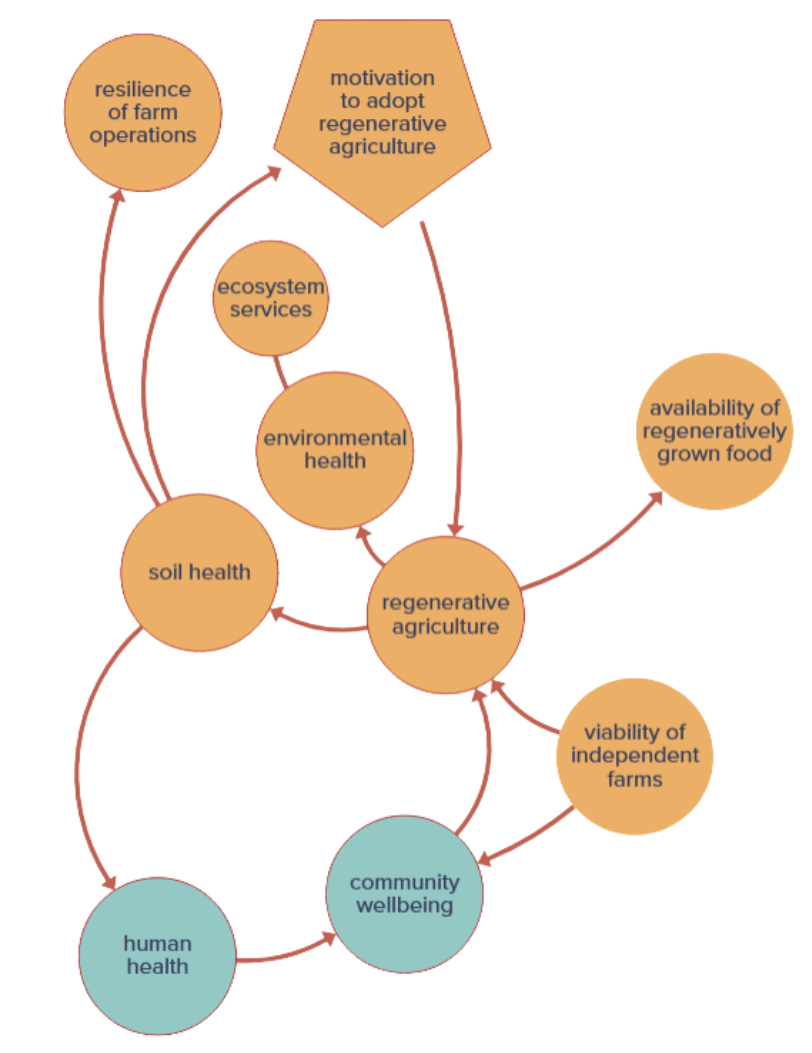
Resilient landscapes mean resilient farm businesses.
As more farms adopt regenerative farming practices, improvements in soil health will enhance on-farm ecosystems and operations mitigating disturbances such as droughts and extreme heat. Increased resilience supports the viability of more farming operations. This in turn reinforces the benefits of on-farm regenerative practices.

Soil health nurtures human health.
Improved soil health supports farm viability; improved plant health enhances the nutritional value of food crops; more nutritious food enhances human health. As a result, farms with regenerative practices mean fewer health problems for farmworkers and neighboring communities. As regenerative agriculture expands, more people gain access to healthy food, which in turn reinforces improved market pathways and revenue for family farms.
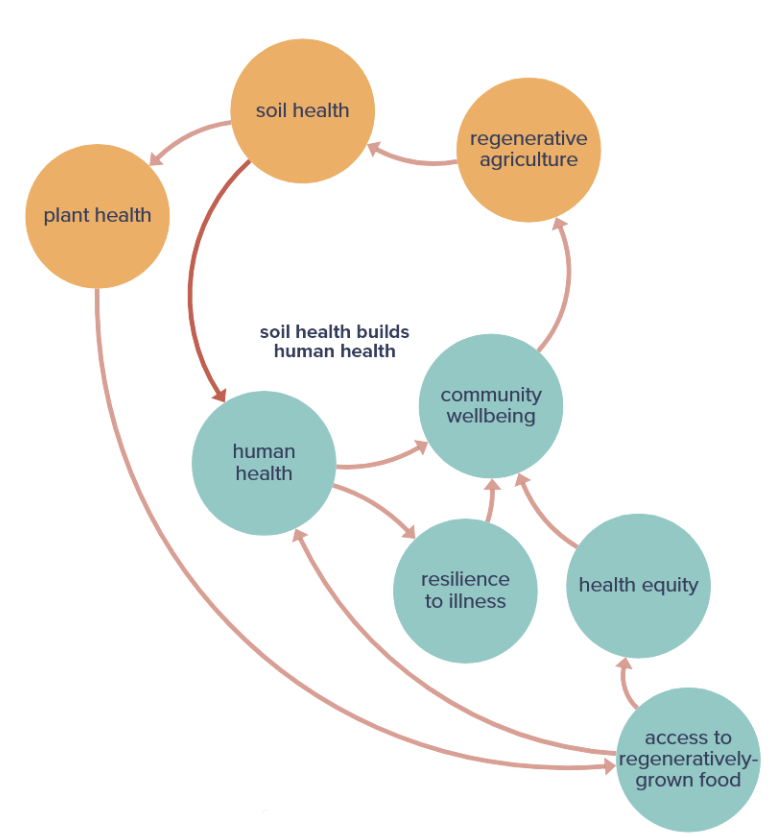
Supply chains reinforce the success of regenerative agriculture.
Successful regenerative farming drives the creation of more supply chain infrastructure such as aggregation, processing, and value-add facilities. As this infrastructure expands, it enables new, alternative market pathways that in turn support farm viability and reinforce regenerative agriculture.
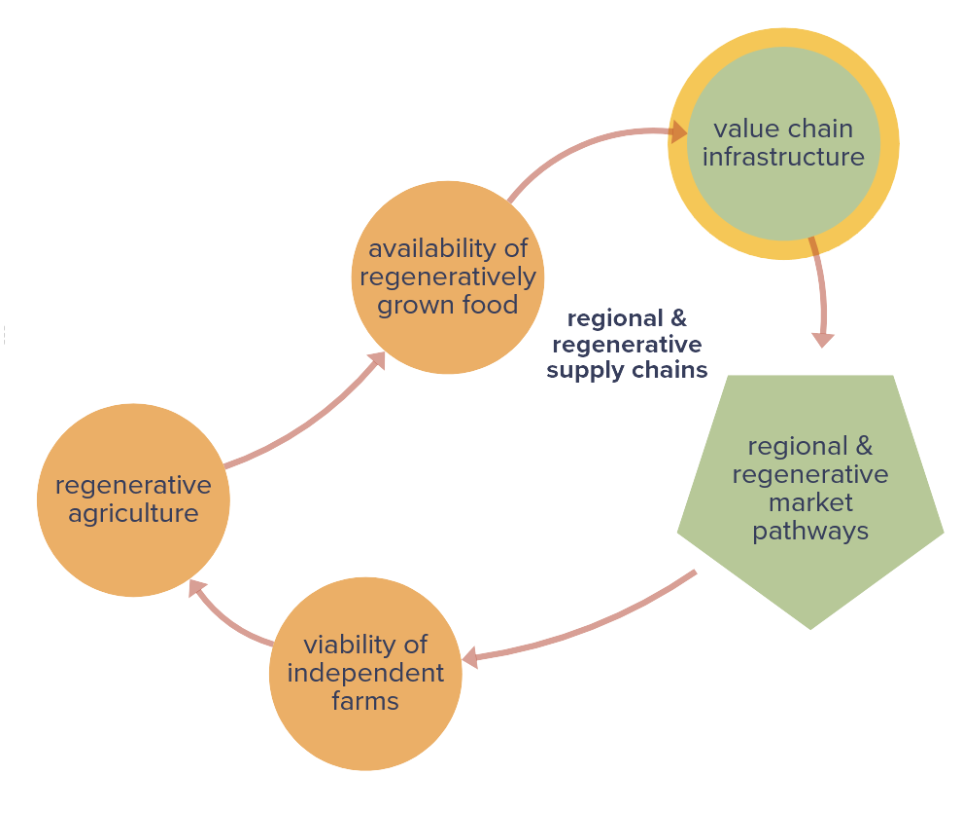
Policy drives regenerative ag success.
As more people support and access regeneratively grown food, government is influenced to enact policies that further enable regenerative food systems (both on-farm and through the supply chain.) These in turn enhance market pathways which reinforce affordability of, and access to, these products.
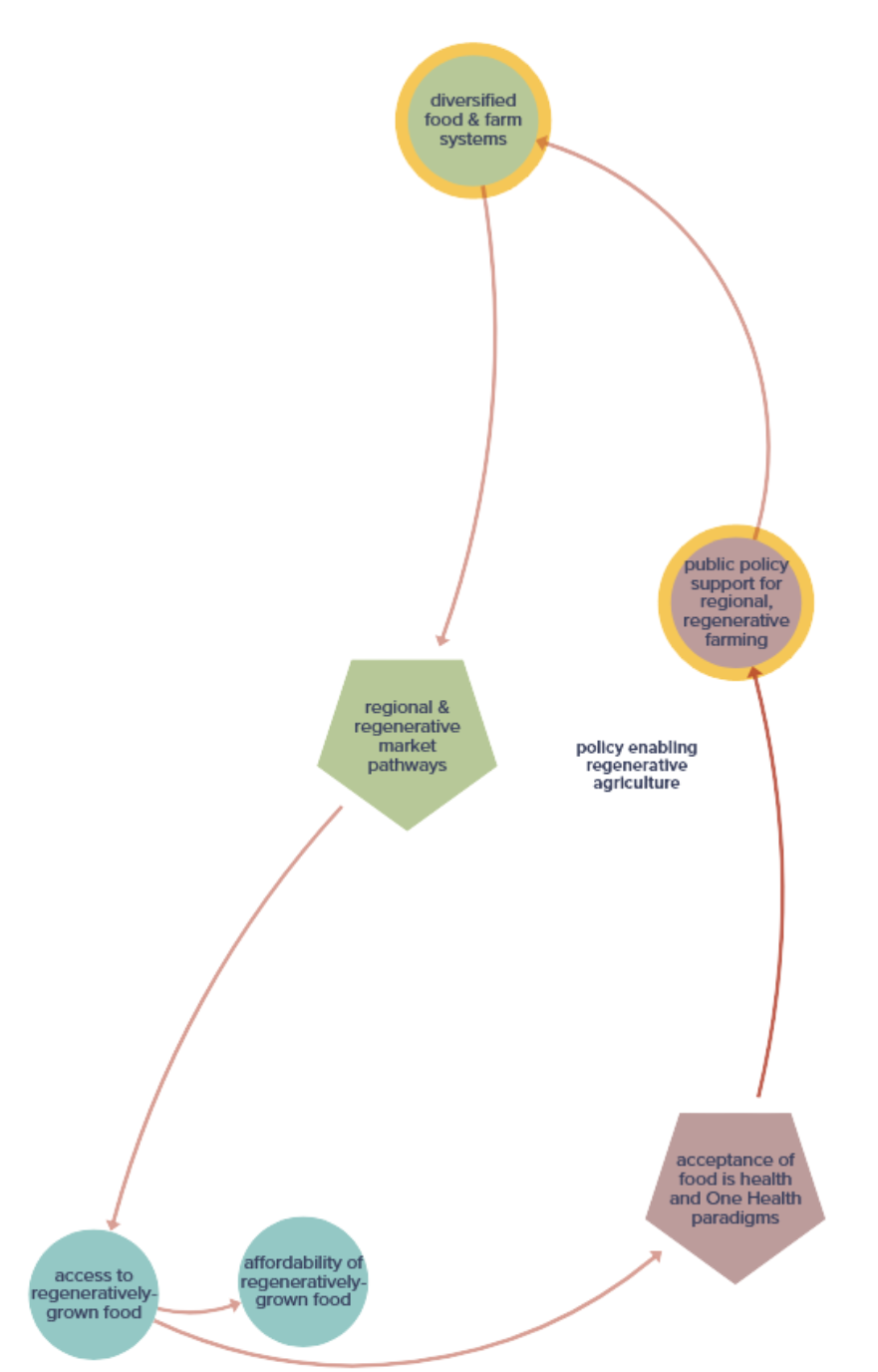
Definitions and standards create a clear foundation.
As definitions, certification standards, and the regulatory processes around regenerative agriculture become clearly defined, it reduces uncertainty for farmers exploring regenerative methods to produce foods and fiber. Increased adoption illustrates to other regenerative farmers and ranchers that policies are supportive and markets are accessible. Long-term adoption of regenerative farming practices becomes more prevalent across the region and leads to a higher volume of food being grown in these ways, necessitating more development of market pathways for regenerative foods.
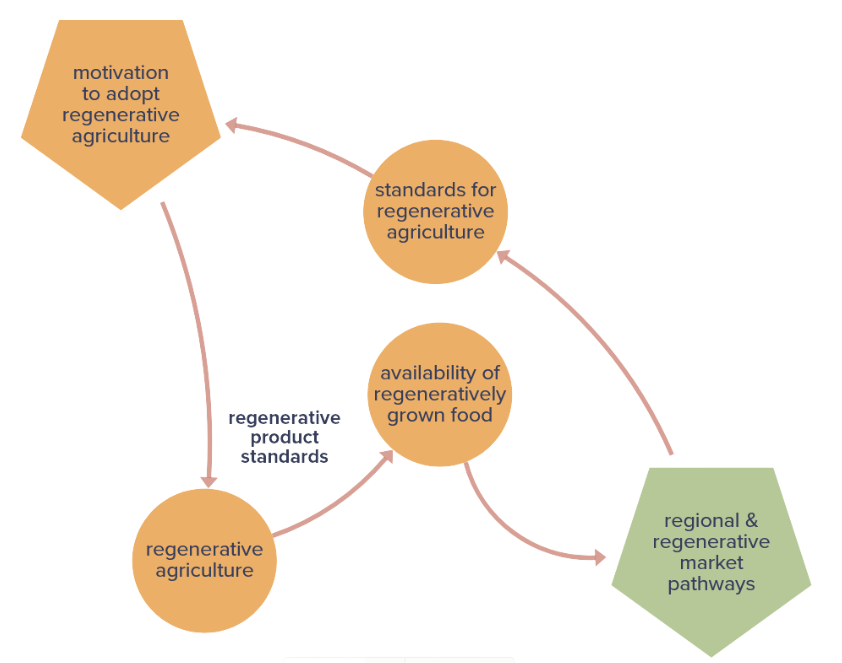
Brakes on consolidation.
As consolidation intensifies in food and farm systems, the largest entities in the system, including foodservice management companies and retailers, are able to command greater market power and secure greater profits at the expense of independent agricultural producers. Policy interventions that support diverse, regional, regenerative food and farming systems help put the brakes on runaway consolidation.

Institutions have unusual leverage to shift the system.
Schools and universities, military bases, hospitals, food banks, prisons, and senior care facilities. are community-based institutions that provide societal functions and typically operate around formal structure and bureaucratic processes. Dining facilities in institutions are an access point with significant market power for regional and regenerative products. Sourcing these types of ingredients for foodservice not only supports regional farms, it also provides a consistent source of nutrient-dense food to ensure the health and wellbeing of students, patients, servicemembers, and employees.
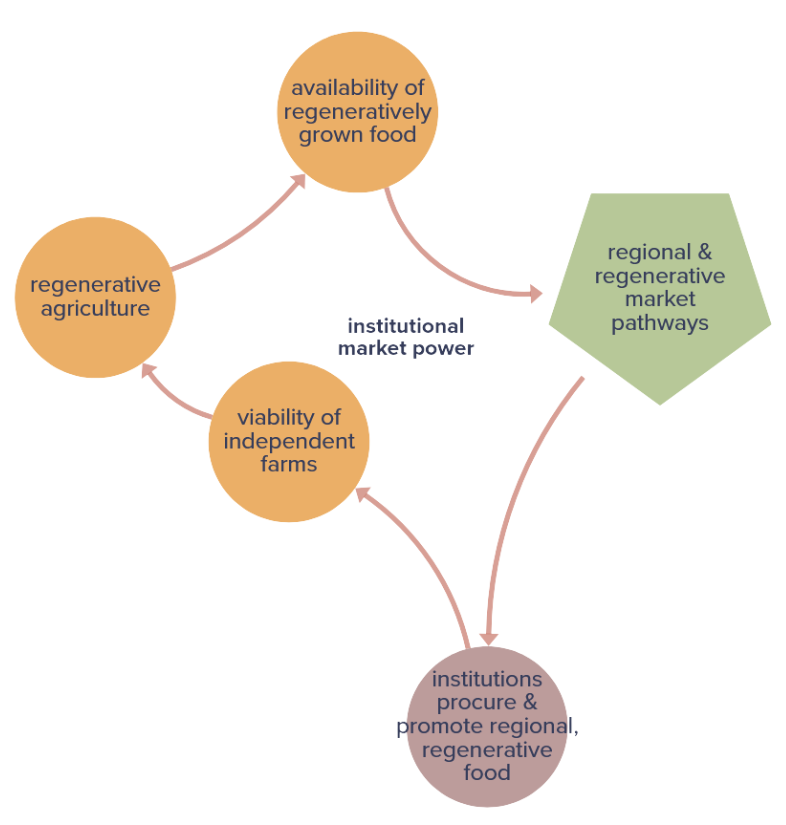
Institutions need champions.
Champions within these institutions are critical in driving change and supporting the internal structural and procedural shifts needed to enable regional, regenerative food procurement. As trusted leaders affirm the connections between food, farming, and human health, we see a growing acceptance of the “food is health” and “One Health” paradigms, which views food not just as fuel, but as a preventative factor against non-communicable diseases. As acceptance of this concept grows, so too does a foundation of support for institutional change.
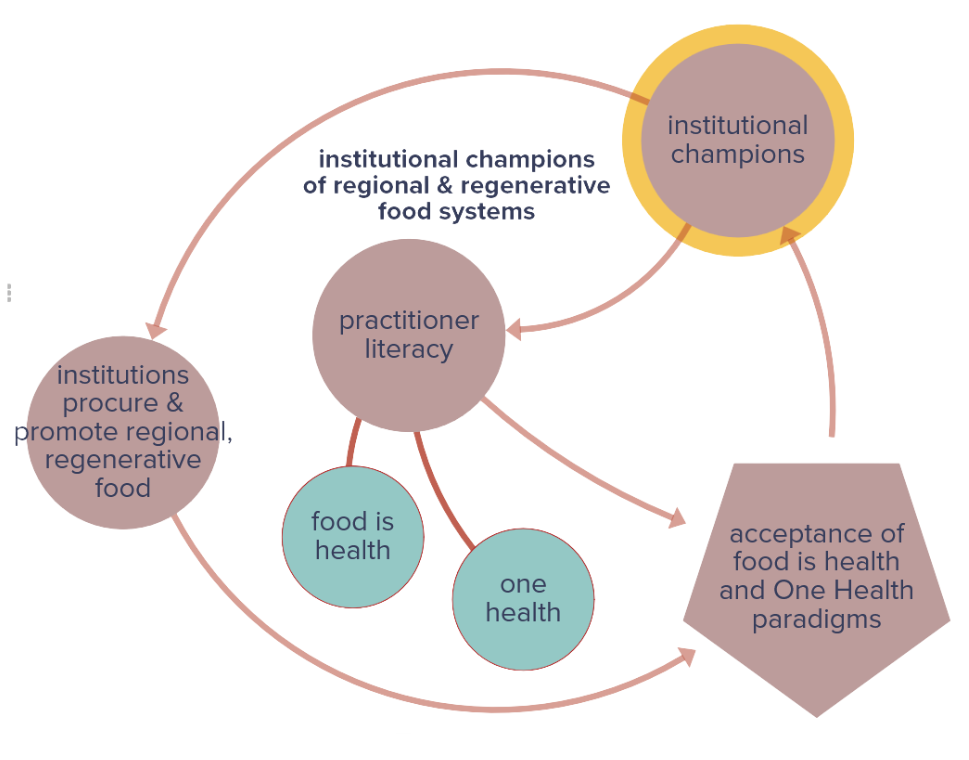
Institutions support health equity.
As institutions serve more regional, regenerative food, they are making it more accessible across the community, which contributes to greater health equity and, in turn, resiliency and overall wellbeing. This ultimately supports a stronger community, reinforcing the positive impacts of sourcing regional, regenerative food for institutional foodservice.
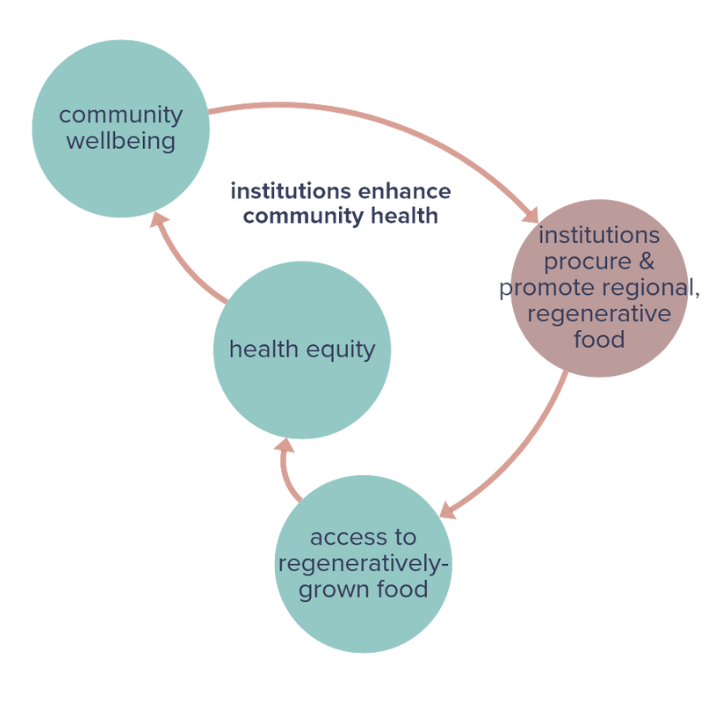
All of these dynamics weave together, and form the basis of Basil’s Harvest’s work in the world.
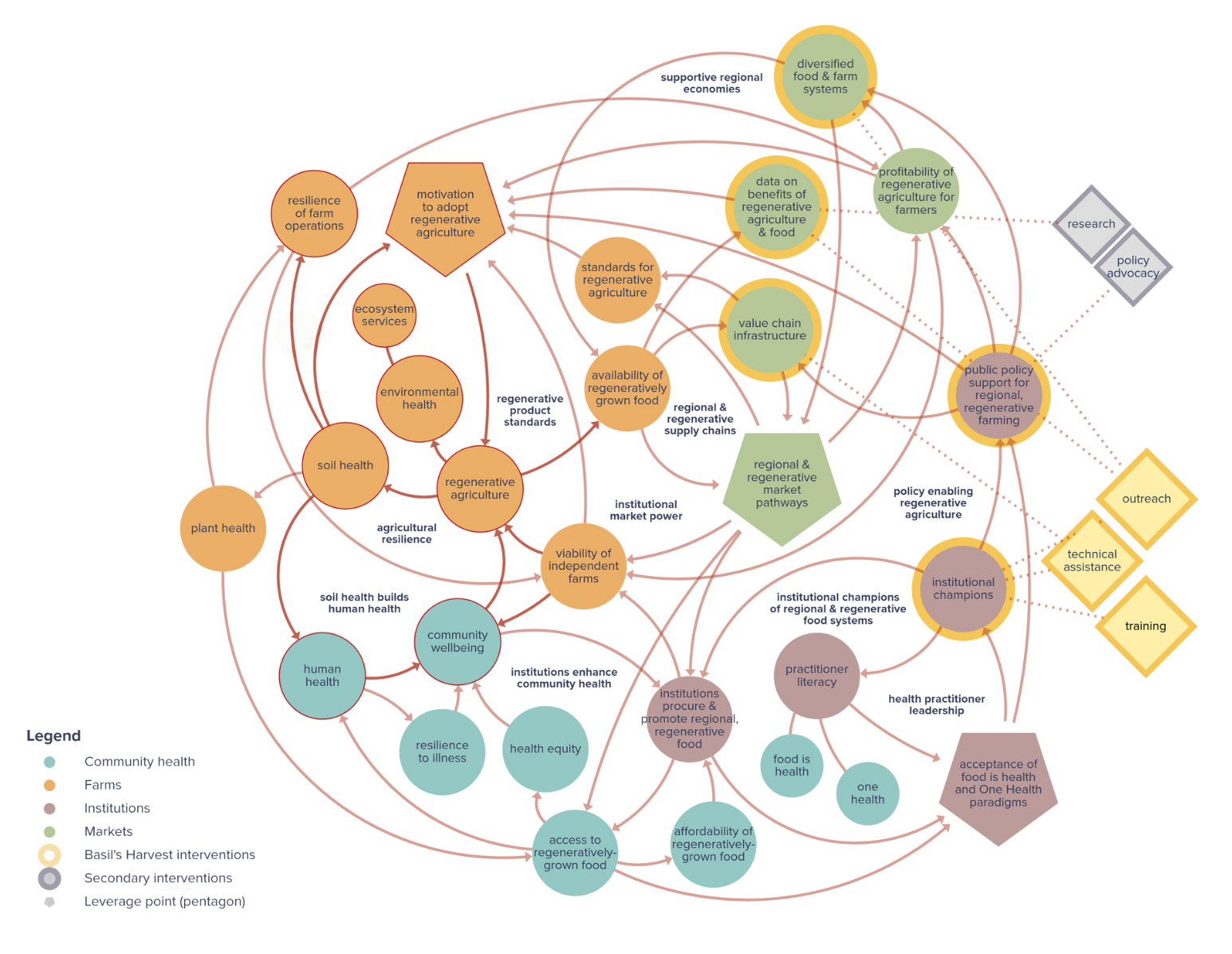
We strive to transform the food and health landscape by utilizing three primary interventions (depicted as gold diamonds):
- Technical Assistance: We partner with institutions and vendors to transform their food systems through strategic support. Our work includes developing procurement plans that connect regional farmers with institutional buyers for improved supply chain logistics, creating delicious recipes and performing nutritional analysis to ensure federal guidelines are met, and navigating food safety regulations.
- Training: We co-develop evidence-based curricula that build practitioner literacy across healthcare and food service sectors. Our programs integrate culinary medicine into medical education, teach health care professionals about soil health and nutrient density connections, and train foodservice staff to incorporate regional, whole/minimally processed ingredients into institutional menus. We equip professionals with Food is Health and One Health knowledge to champion sustainable food systems within their institutions.
- Outreach: We share transformative stories and actionable insights through our Impact Library, Farm-to-Institution (F2I) Toolkit, and thought leadership partnerships. We empower medical professionals, dietitians, foodservice providers, and sustainability directors with practical resources to implement change. Our outreach creates a network of champions—from farmers to policy makers—who understand how regional, regenerative food systems improve both human and planetary health. Sign up for our mailing list for news and updates on our work!
Basil’s Harvest supports partners via two secondary interventions (depicted as blue diamonds):
- Research: We support collaborative research to increase the availability and quality of data demonstrating the connections between soil health and human health. This data supports and amplifies the effectiveness of our other interventions by contributing to a foundation of knowledge for collaborative projects, training programs, and outreach to leadership in institutional supply chains.
- Policy Advocacy: We support policy actions that bolster regional and regenerative farming and supply chains, and affordability of healthy, regeneratively-grown food. These types of policies support our other interventions by creating more funding opportunities and infrastructure for regional & regenerative agriculture programs and partnerships.
We engage with partners using these primary & secondary interventions around key intervention points (depicted with a gold halo), to influence three leverage points (depicted as pentagons), or the “levers of change” which hold great potential to transform food, farm, and health systems.

In other words, these leverage points hold meaningful opportunities…
- There is growing recognition that how food is grown matters to human nutrition and health.
- Policymakers are primed to support initiatives that build community health and wealth and address climate change.
- There is growing infrastructure to support regenerative land management practices and more examples of how these are benefitting farmers’ triple bottom line (economic, social, and ecological).
- Communities are gaining knowledge and skills to foster vitality, equity and resilience.
- Institutions have the power to support wider community health & wealth, and drive regenerative land management.
- Learning through experience fosters deep connection with land and people.
- When people experience real regeneratively grown and thoughtfully prepared food, they will be inspired and won’t go back to the old way of doing things.
- The growing movement to reshape the future of food brings support for regenerative food systems
…to drive transformation across food, farm, and health systems.
- Communities across the region have access to and are choosing affordable, locally produced, and nutrition-rich foods.
- Communities most historically impacted by poor health outcomes are thriving and healthy; health equity is strong.
- A higher number of farms and acreage are under production systems that nurture agroecosystem health.
- More farms and farmers are thriving with strong local markets and supply chain infrastructure.
- Rural and urban communities are resilient to economic & environmental disruption.
- It’s common knowledge that how food is grown affects community health and nutrition.
- Health sector leaders and institutions are promoting food as medicine, using an environmental nutrition lens.
- All those working to participate in community wellbeing through food have the spiritual and community support they need to make these changes.
Our Theory of Change in Action
- The Regenerative Agriculture in the Heartland Project served as a real example of a farm-to-hospital model implemented in the upper Midwest region of the United States, bringing regenerative oats from Doubting Thomas Farms to hospital trays at OSF Saint Francis Medical Center.
- Published in Frontiers in Nutrition, this review titled From soil to health advancing regenerative agriculture for improved food quality and nutrition security “examines the global challenges posed by the industrial agriculture model, particularly regarding ecosystem degradation and an inability to meet human nutritional needs..” Carl L. Rosier, Anya Knecht, Jasia S. Steinmetz, Amy Weckle, Kelly Bloedorn, Erin Meyer (October 16, 2025)
- Regenerative Ag in the Heartland: Paving the Path to a Regional Farm-to-Military Value Chain is a farm-to-military initiative which aims to transform military nutrition by embedding sustainability and health into national defense logistics. It aims to create a new farm-to-institution market channel between local producers and the National Guard in IL and MN, and is being implemented as part of the Department of Defense’s Go For Green (G4G) Initiative.
- Healing from the Ground Up is a 1.5 day summit hosted by Basil’s Harvest that bridges the gap between agriculture, food systems, and healthcare! With expert presentations, group discussion, and information-sharing, the summit features opportunities for attendees to engage, learn, and grow.
If you have questions about our Theory of Change, reach out to us!
